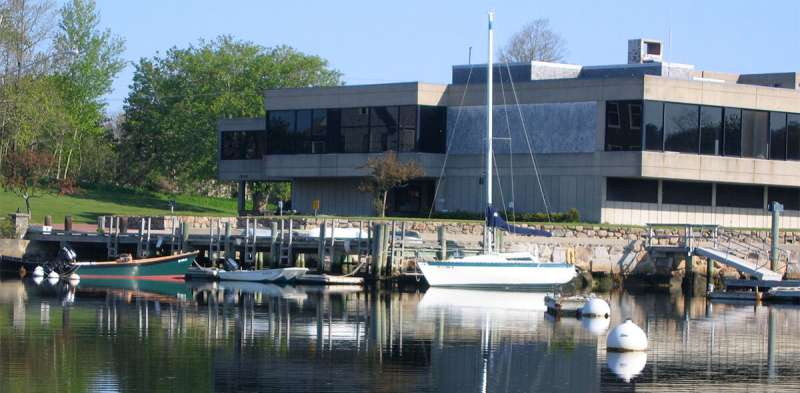Bottom-up is the way forward for nitrogen reduction at institutions

Nitrogen is an element basic for life—plants need it, animals need it, it's in our DNA—but when there's too much nitrogen in the environment, things can go haywire. On Cape Cod, excess nitrogen in estuaries and salt marshes can lead to algal blooms, fish kills, and degradation of the environment.
In a study published in Environmental Research Letters, scientists at the Marine Biological Laboratory (MBL) Ecosystems Center examine ways to reduce the nitrogen footprint of smaller institutions, like the MBL, by focusing on a bottom-up approach.
"This bottom-up approach is all about balancing the needs of various stakeholders to come up with the best, most feasible solution for the institution," says Sarah Messenger, lead author and research assistant in the MBL Ecosystems Center.
At the MBL, and many institutions like it, the biggest sources of nitrogen are food production and consumption. That's because nitrogen is used as fertilizer to grow our food and produce the feed that supports livestock animals.
Researchers found that switching to an all-vegan diet (no animal products) in dining halls would make a huge dent in the institution's nitrogen footprint, but MBL's dining team called it a non-starter. The kitchen staff isn't trained for that, nor would the customers be open to it, they said. It would also mean big changes for the department's budget.
"The problem here is not just at an institutional level, but at a family level, at the community level, at regional, state, and national levels. The problem is that these things cost a lot of money and they are difficult to implement," says Javier Lloret, MBL research scientist.
The scientists also found that upgrading the institution's HVAC systems, fitting new, more efficient windows, or going 100% solar could cut the institution's nitrogen footprint. But all of those solutions come with a large price tag.
"The MBL is really small, so we don't have the personnel resources of larger Institutions," says Messenger. "We don't have a sustainability department. We have limited manpower, limited resources, and limited money that we can put towards making these big changes."
But what the MBL and many smaller institutions have are people who are experts at what they do. So instead of searching for a solution to the institution's nitrogen footprint that could require a large budget commitment from the director or the board of trustees, the scientists identified on-the-ground stakeholders in the departments that were responsible for the biggest portion of MBL's nitrogen footprint—food and facilities—and modeled "low-effort" solutions for those departments. They focused on ideas that didn't require new personnel, a large investment or a change in normal operations, and could be accomplished over the short term (three to five years).
"The goal was to only model changes that these department leaders could implement in their departments without needing sweeping changes and institution approval," says Messenger, adding that the team "completely disregarded any reduction strategies that weren't acceptable to the people that know their department best."
For dining services, an all-vegan or all-vegetarian menu was a no-go, but replacing 20% of MBL's beef use with chicken or fish resulted in a 2.6% reduction in the institution's nitrogen footprint, according to the researchers' model. Swapping out 10% of meat meals with vegetarian options would reduce the MBL's nitrogen footprint by 5.7%. They found that serving less meat could also result in a reduction of costs to the catering department.
The MBL's facilities team was already implementing an upgrade of the institution's lighting, so the research team adding those upgrades to their model—calculating a 7.3% drop in the nitrogen footprint of the utilities sector and a 2% drop in the MBL's overall nitrogen footprint. Purchasing extra renewable energy credits to power the MBL with solar energy was also modeled.
Combining all the approaches, the scientists calculated a 7.7% drop in the MBL's nitrogen footprint with no major disruption to operations and no additional monetary support from the institution.
"It might not seem like a lot, but 8% is a lot of nitrogen," said Lloret. "These small changes do make a difference."
While no measures have been implemented yet, the team said they were optimistic by the response from the department stakeholders and hoped that the MBL, and other small institutions like it, could use this paper to examine ways to minimize their nitrogen and carbon footprints.
"We all want the same thing," says Messenger. "We would all love the MBL to reduce the impact on our environment as much as possible, but exactly how to get there is challenging. We're hoping that this paper can be a map forward."
More information: Sarah Messenger et al, Identifying and assessing effectiveness of alternative low-effort nitrogen footprint reductions in small research institutions, Environmental Research Letters (2021). DOI: 10.1088/1748-9326/abd9f6
Journal information: Environmental Research Letters
Provided by Marine Biological Laboratory




















